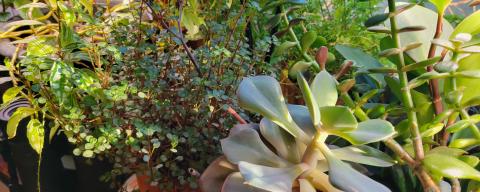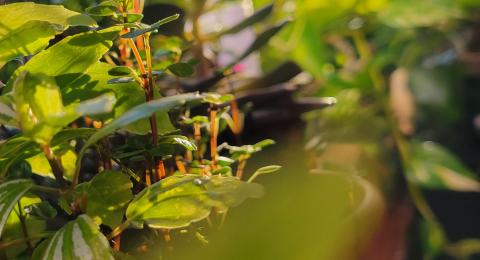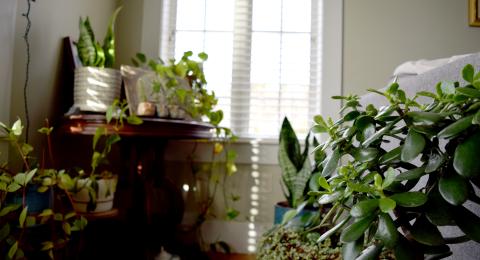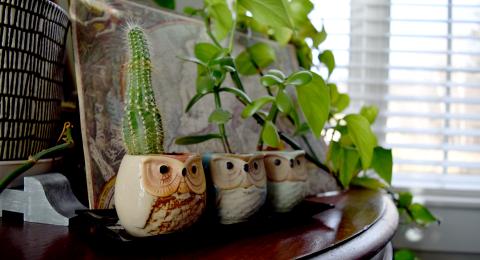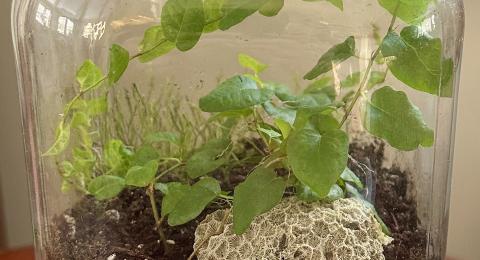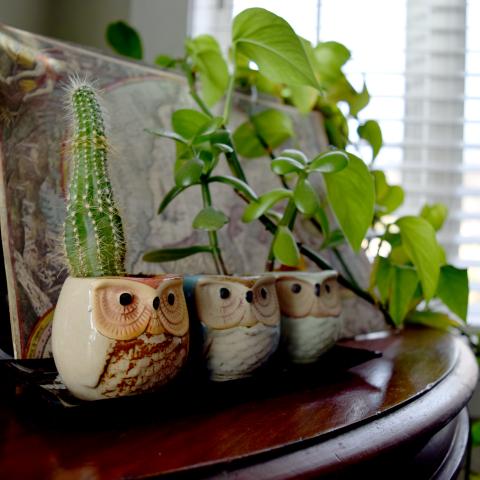How can I increase the humidity indoors for my houseplants?
One of the most common issues for keeping your houseplants healthy during the winter months in New Hampshire is providing sufficient humidity, which can be a real challenge when the indoor air feels excessively dry and relative humidity is low.
Relative humidity (RH) measures the amount of moisture that is in the air compared to how much it can hold at a certain temperature, and is expressed as a percentage. In winter, indoor air tends to be drier for two reasons. First, cold air holds less moisture than warm air, so when drier outdoor air enters and mixes with warmer indoor air, it doesn’t add much moisture. Indoor heat sources raise the air's capacity to hold moisture by increasing the temperature, but rarely is there enough moisture available to fill it. As a result, moisture is drawn from things like plants and people, making everything feel drier, and the RH still fairly low.
Most houseplants (excluding cacti, succulents and a few others) prefer a relative humidity range of 40-60%, although tropical species thrive at higher ranges of 70-80%. If your plants’ foliage is starting to look dry, brown and brittle around the leaf margins, it could be a sign that they need some extra humidity. First, ensure that plants are placed in areas that will promote, not hinder, a more humid environment. This means keeping plants away from heat vents, radiators and outside doors, and potentially placing them in rooms that can be more humid, such as bathrooms or kitchens, provided they can still get the light they need.
You may also consider purchasing a portable humidifier for more consistent control. Placing the humidifier close to your plants offers the most benefit (particularly in larger rooms,) and will likely need to be left on for multiple hours every day to provide enough humidity. Pairing it with a digital thermometer and hygrometer will help you monitor how much the humidifier is helping to maintain your desired RH.
If relocation or using a humidifier aren’t feasible options, consider these alternatives to help provide the humidity your plants need:
- Group plants together – Water that evaporates from the potting media or transpires from the leaves can increase relative humidity by creating a microclimate. Placing more plants together can expand this effect. However, this strategy works best with several plants and/or in a small room with low airflow to limit the diffusion of that moisture to occur around the plants instead of throughout the surrounding space.
- Pebble tray – Filling a two- to three-inch-deep tray with pebbles and water and placing your pots on top of the stones (ensuring that they are not sitting in the water,) can provide a small benefit for humidity. Like plant grouping, the effect of this method is maximized when used with multiple plants and in rooms with low air circulation.
- Terrariums, cloches and aquariums – All of these glass enclosures are excellent ways to maintain a high-moisture environment that also add a bit of style to your houseplants’ aesthetic! Just make sure to occasionally lift the lid of any closed vessel to prevent excess moisture build-up. Closed terrariums are best suited for smaller and compact plants.
UNH Extension Master Gardener Terrie Wallace has been growing plants in her New Boston home for 24 years. She has some advice for those who have plants that are not thriving during the Northeast winter. ”Don’t give up hope and discard them. Plants are resilient. If a plant still has signs of life, try to maintain it until spring arrives and conditions in your home become more supportive of your plant.”
Pathogens
Overwatering of indoor plants will ultimately lead to root rots usually caused by fungi or fungal-like organisms. Symptoms of root rots/crown rots include yellowing, browning, and dieback of the leaves and browning or blackening of the crown and or roots, and poor growth. Root rots may also paradoxically cause wilting even when the soil is wet because the roots are so damaged that they cannot transport water to the leaves. - from "Winter Indoor Plant Problems, 2023, https://extension.umd.edu/resource/winter-indoor-plant-problems/
Summary
To increase indoor humidity for houseplants during dry winter months in New Hampshire, using a portable humidifier near the plants and monitoring humidity levels with a sensor can provide the most benefit. Grouping plants together creates a microclimate that boosts humidity as well. Pebble trays under pots can also help a little by adding some moisture to the air. Glass enclosures like terrariums maintain high humidity naturally but may need occasional ventilation. Additionally, keep plants away from heat sources and drafty spaces and in rooms that can have more humidity like bathrooms or kitchens. Avoid overwatering to prevent root rot.
Ask Questions, Get Ideas
Staff experts, Master Gardeners and Natural Resource Stewards connect you with the resources of the University of New Hampshire.
